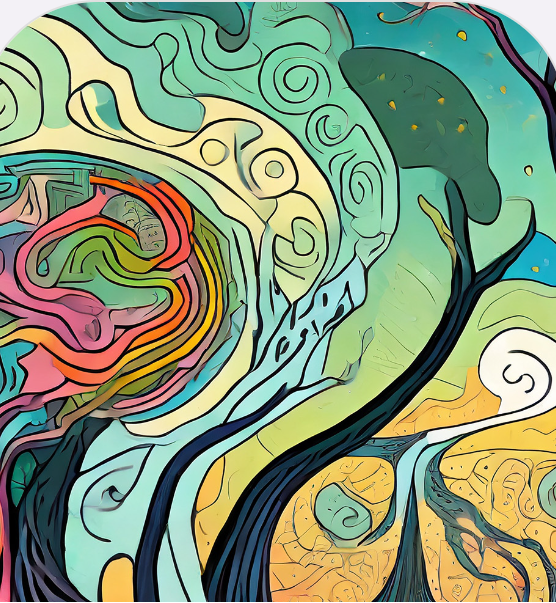The Fruits of the “Tree of Knowledge”
For centuries, humans have explored the mysteries of their subconscious, striving to understand and master their own minds. This fascination dates back deep into human history and has taken various forms depending on culture, philosophy, and time periods. Here is a brief journey through these different stages, not covering all directions but those I find most significant:
- Antiquity, Astrology, Esotericism:
In ancient cultures such as Egyptian, Greek, Hindu, and Chinese, there were astrological, esoteric, and mystical practices aimed at delving into the realms of knowledge about the world, consciousness, and the subconscious. Interpreting planetary influences, rituals, and the use of substances were commonly practiced to achieve higher states of consciousness. Traces of these traditions remain alive in many cultures and countries today, such as ayahuasca in South America, peyote in North America, and Soma in the Indo-European region. - Philosophy and Religion:
In various philosophical systems and religions, concepts about the mind and subconscious have appeared. For example, in Buddhism, Vipassana meditation aims to understand the nature of the mind. In Hinduism, yoga practices focus on achieving unity with the Divine through control over the mind. The I Ching and Taoism sought a balance between the environment and man, between his conscious and unconscious nature. Prayers, meditations, and contemplations still serve as living tools for exploring subconscious content. - Middle Ages and Alchemy:
During the Middle Ages, alchemists sought not only to transform ordinary metals into gold but mainly to achieve spiritual transformation. Their work can be interpreted as a symbolic process of transforming consciousness and the subconscious. - Renaissance and Occultism:
In the Renaissance period, occult sciences such as alchemy, Kabbalah, and astrology developed, merging in the pursuit of knowledge about consciousness and the subconscious. Mystics and alchemists like Paracelsus and Giordano Bruno sought a deeper understanding of the spirit and its connection with the mind. - Dreams and Shamanism:
Shamanic traditions from various cultures have always attached great importance to dreams. Shamans regarded dreams as gateways to other worlds, sources of guidance from spirits and spiritual guides. Practices such as dream journeys or dream interpretation were an integral part of shamanic rituals. To this day, dream interpretation is an important path to self-knowledge, not only in professional therapeutic support but also in individual exploration and insights. - Psychoanalysis and Freud:
In the 20th century, Sigmund Freud introduced the concept of the subconscious into psychology, arguing that unconscious desires and thoughts have a key influence on an individual’s behavior. The development of psychoanalysis provided tools to analyze and understand areas of the mind that are beyond our conscious awareness. - Jungian Depth Psychology:
In the 20th century, Carl Gustav Jung introduced the concept of the collective unconscious, proposing that there is a hereditary aspect of the unconscious that connects an individual with all of humanity. His work on dream analysis and archetypes revealed the mysteries of the depth of the subconscious and directed the development of depth psychology, which today is the foundation of modern psychology and psychotherapy. - Transcendental Meditations:
In the 1960s and 1970s, meditation techniques such as Transcendental Meditation became popular, aiming to achieve a state of heightened awareness and access to the subconscious. - Modern Transpersonal Psychology:
As transpersonal psychology developed, shamanic concepts began to influence the study of human consciousness more strongly. This psychology focuses on the spiritual and transcendent aspects of human life, combining elements of psychology with traditional spiritual practices like shamanism. Transpersonal psychology explores areas of the mind beyond consciousness. In this regard, the role of Stanislav Grof should be emphasized, whom I would love to write about in a future post, as I highly respect his contribution to the development of self-knowledge and understanding of our place in the universe. - Psychedelics and the Search for Spiritual Experience:
In the 1960s and 1970s, the hippie movement and counterculture popularized experiments with psychedelic substances like LSD, MDMA, and psilocybin, in search of deeper spiritual experiences. People at that time sought new ways to understand the subconscious and explored expanded states of consciousness. - Modern Exploration of Psychedelics:
Contemporary research on psychedelics indicates their enormous potential in exploring unconscious content, not only in a therapeutic context but also for inducing profound spiritual experiences. Psychotherapists are experimenting with the controlled use of psychedelics in treating trauma and personal development. More countries are allowing controlled access to psychedelic substances not only for therapy but also for so-called “personal use.” - Meditative Practices and Mindfulness:
Contemporary meditative practices, mindfulness, yoga, etc., based on Eastern spiritual traditions, focus on exploring the deeper layers of the mind. These techniques help in understanding and mastering the subconscious, as well as achieving psychological balance.
The history of exploration in the subconscious is fascinating because it reflects the evolution of human thought over time and the diversity of cultures. These pursuits remain a part of the human experience, showcasing the ongoing quest to understand the deeper layers of our own consciousness, both individually and collectively. This is where Human Design comes in, which, as the first system in the history of our civilization, shows a precise map of our subconscious. GeneKeys further develops this map, providing a guide for development on both spiritual and mystical paths.
What was once a dream for generations is now available to everyone, thanks to systems that synthesize many previous paths of self-knowledge. Imagining the human tree of knowledge and following its fruits, Human Design and GeneKeys are the most mature fruits, though probably not the last.
